Greek salad (or Horiatiki salata) (Χωριάτικη Σαλάτα)
Greek village salad, or horiatiki, is a staple in every Greek kitchen. An amazing combination of vine-ripened tomatoes, cucumber, red onion, Kalamata olives and feta. Although there are some variations, olive oil and Greek oregano are staple dressing ingredients.
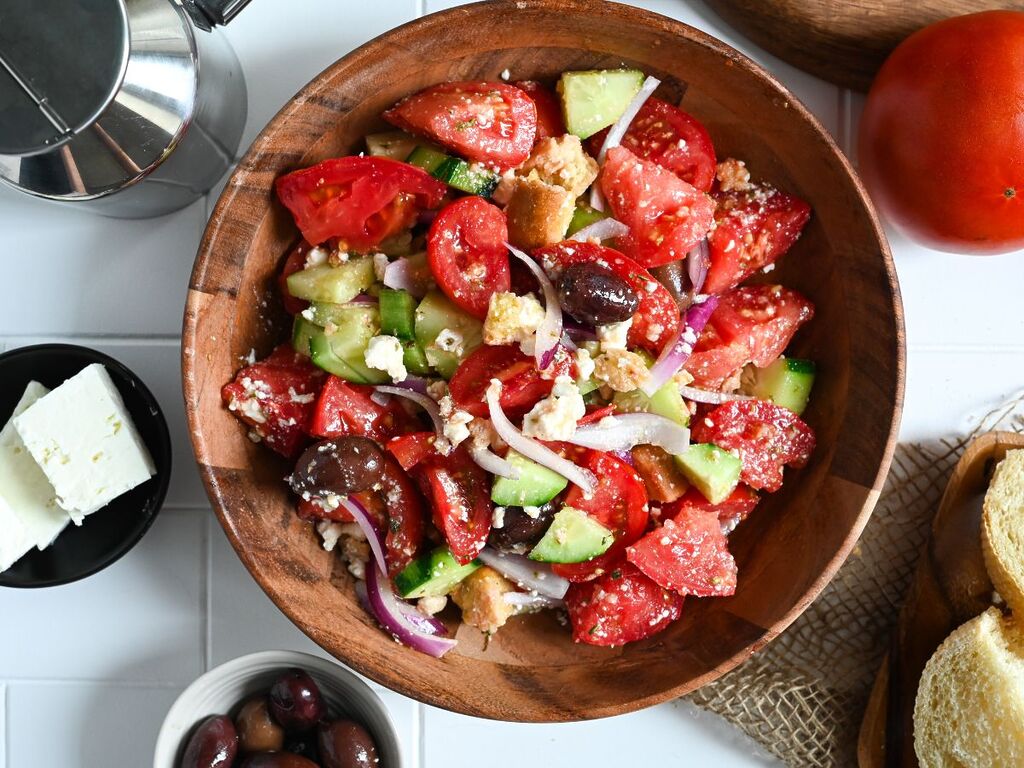
They say you are what you eat. If that’s the case, then in the summer months, I am a villager. When garden tomatoes have ripened, I use them to make, and eat, delicious Greek salad, also called a horiatiki salata (horio means village in Greek). I eat this salad every day. Not almost every day…but every, single, day. And I never tire of it.
It would be next to impossible to tire of a salad so full of flavour and amazing texture. For me, Greek salad or horiatiki salata is a gift of summer; easy to prepare, filling, deliciously fragrant and healthy. In fact, the only down side is that I live in Canada, where local, vine-ripened tomatoes are not readily available year round.
Key ingredients
Although the two versions of Greek salad which I present below differ somewhat, you will notice that neither version contains lettuce. That’s because lettuce has no place in a horiatiki salata. Now, I know that there have been great lettuce debates; that there are people who strongly believe that a respectable Greek salad may, or must, contain lettuce. There are also those individuals who believe that there should be no rules; that lettuce can be added, (or not), at will, and that freedom of salad expression is a fundamental right; that a Greek salad is whatever the person making it, says it is. I say, NO WAY! Freedom is great, and you can add whatever you want to your other salads…but if you’re making a Greek salad, save the leafy greens for a maroulosalata.
You will definitely need:
Tomatoes I rarely make horiatiki salata if I don’t have access to garden ripe tomatoes. There are other salads to enjoy outside of peak tomato season.
Cucumber I use any cucumbers that I have on hand, including Lebanese cucumbers or English cucumbers. I always wash them of course, and I peel them if I feel that the peel is too thick; otherwise I leave the peel on.
Red onion The onion is kept raw so I prefer red onions because I find their flavour is not as strong as your typical yellow onion.
Feta Greek feta is always used. Made with sheep milk or a combination of sheep and goat milk, the flavour is far superior to Greek-style feta, which is usually made with cow milk.
Olive oil I am generous with the amount of olive oil I add to my horiatiki. A great big glug of Greek olive oil combines with the juices of the tomato and the other ingredients and the result is amazing.
Greek oregano So fragrant! I always have a stash of Greek oregano on hand; it really elevates any dish.
Kalamata olives There are different sizes of Kalamata olives and I use either in my salad. Sometimes I pit them first, but I usually leave them with the pit. A few olives added makes a delicious difference.
Salt Most recipes include salt, but the salt in a horiatiki is really important. It adds flavour, but it also helps to draw out the juices in the tomato, helping to build a delicious liquid that you can literally drink out of the bowl.
You may also want to add:
Green bell pepper Most, but not all Greek village salads include slivers of green pepper. Their peppery bite and fresh, crisp flavour add a lovely dimension to the salad.
Capers To complement the brininess of the olives, capers can also be added to your horiatiki. I love capers because they are easy – no pits to deal with.
Paximadia (barley rusks) These are hard and need to be broken up into smaller crouton-like pieces before being added to the salad. Mix them around and enjoy how they soak up the liquid from the tomatoes and olive oil.
Red wine vinegar A bit controversial, but sometimes adding a touch of red wine vinegar can help augment the flavour of your tomatoes.
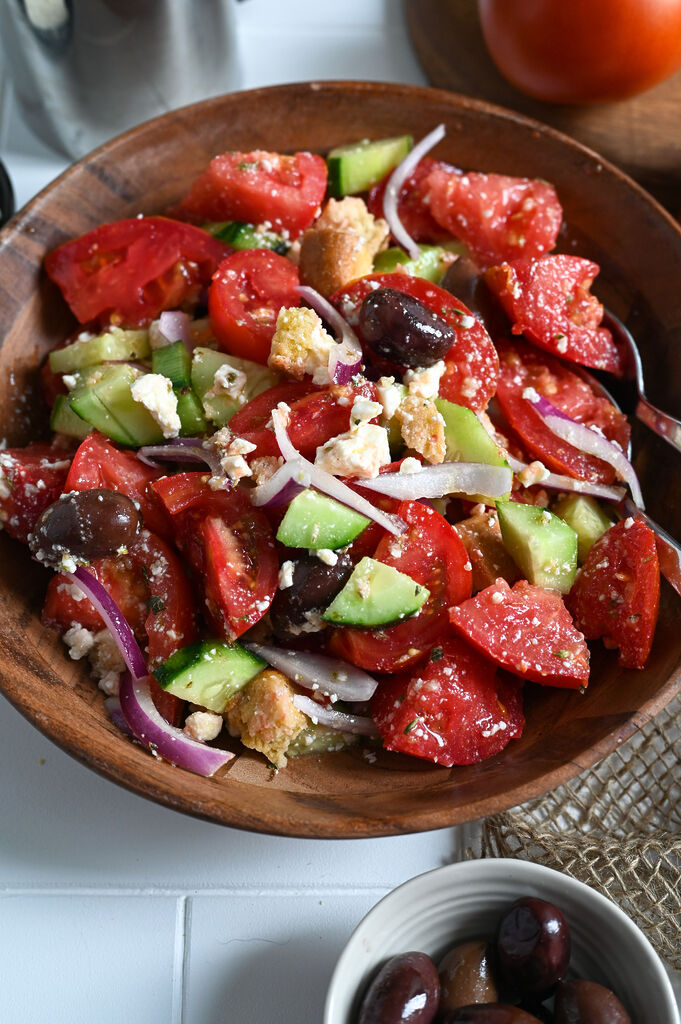
How to make it!
Making a horiatiki salata is such fun, and regardless of how many add-ins you include (will there be green peppers in your salad?), the general idea is to cut up your ingredients as you like, and toss everything together.
Here are a few key points to remember when making the best Greek village salad:
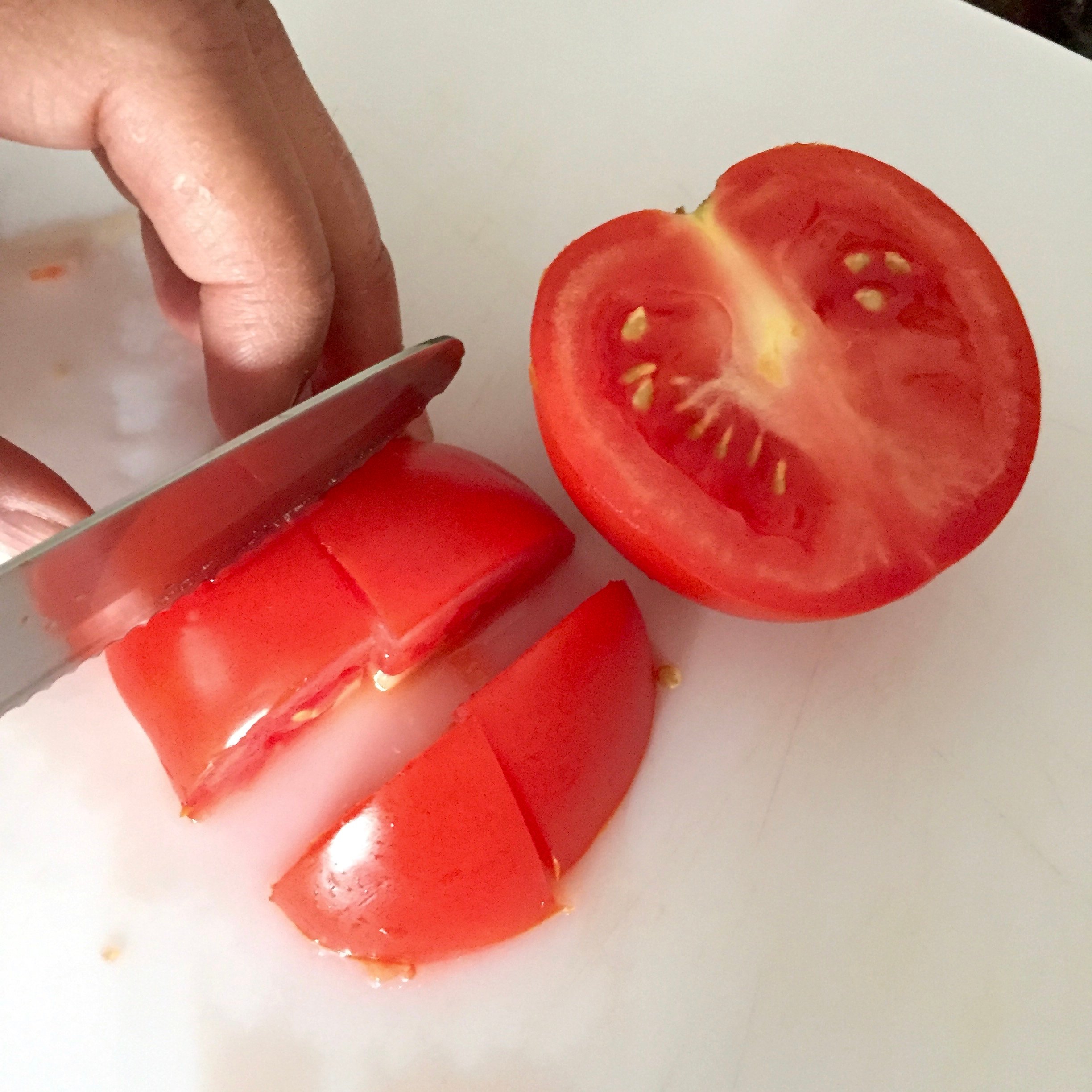
- I like to make my salad and then let it sit for about 15 minutes before serving it. This allows the juices of the tomato to really blend together with the oregano and olive oil – so good!
- Your tomatoes and cucumber should be cut into bite size pieces.
- After washing your vegetables, be sure to dry them well – you don’t want water diluting any of the flavours.
- Traditionally, a horiatiki salad is served with a slab of feta sitting on top of it – not cut into chunks, not crumbled. Know this, acknowledge it, and then do what you like with the feta :).
- Pitting your Kalamata olives makes it easy to eat them in your salad, but traditionally, the pit is left in.
- Not everyone loves eating raw onions. If you want the flavour of the onion, without actually eating it, leave the onion in larger pieces in your salad. Then, after tossing and imparting their flavour, they can be removed.
Recipe substitutions
If you can’t find Kalamata olives (I`m really sorry) you can always use a different type. You can read about some different olive variations here. If all you can get your hands on however are the canned, pitted, black or green olives…forget it! These taste like plastic so it is better to go olive-less.
I sometimes use shallots instead of red onion in my Greek horiatiki salad. They are equally mild and delicious.
Recipe variations
Although my parents and my sister Billie make horiatiki salata as often as I do in the summer, we each have our own variation. On day, over coffee and notebooks, while planning our future recipe posts, we got to talking about Greek salad and it became clear that we each had our favourite way of preparing this staple Greek dish. So, we decided that it might be fun to showcase both mine and Billie’s variations, which we very creatively named: Greek Salad 1 and Greek Salad 2. Both are delicious, and quite similar, however you may notice that Greek Salad 1 is tidy, structured, classic, and very well organized…like one of us (ahem…me). Greek Salad 2 on the other hand is creatively scattered, somewhat carefree, and, well, frankly, a little bit messy…like the other one of us. We wonder if you can guess which one of us created each salad 🙂 .
Greek Salad 2 includes paximadia, broken up into bite sized pieces, which act as rustic Greek croutons in your salad. Paximadia are typically barley rusks; you may recognize them from the other traditional Greek salad called Cretan dakos. They are quite hard and benefit from soaking in the salad juices which get created when you mix together the tomatoes, olive oil and, in the case of Greek Salad 2, red wine vinegar. The inclusion of paximadia can replace the need for some nice dunking bread…but not necessarily.
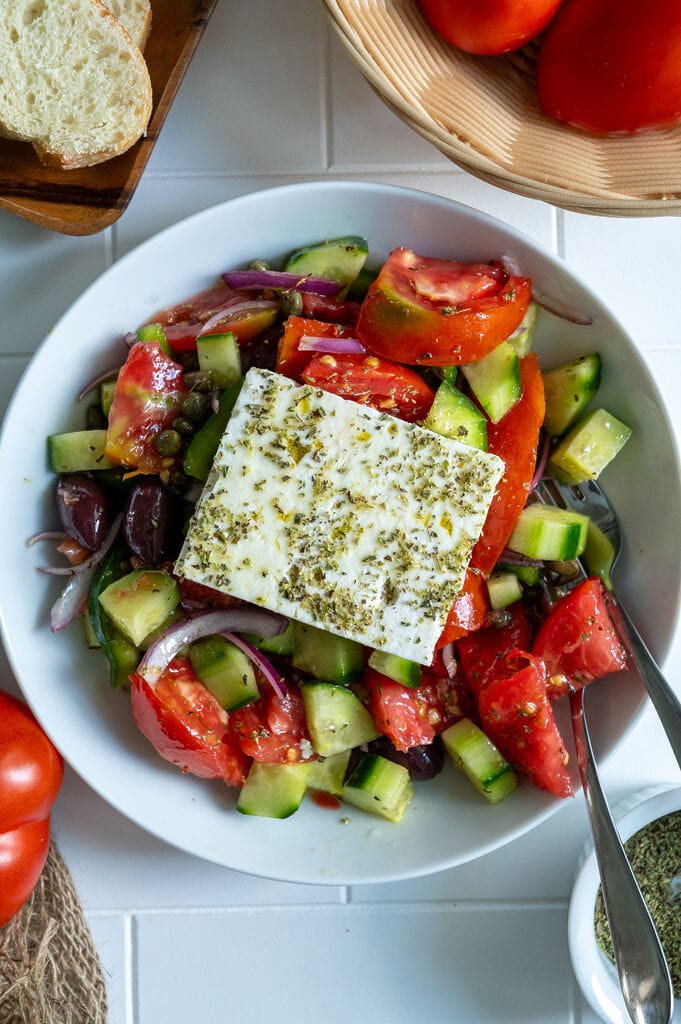
Helpful hints
Great tomatoes are key!

The main component of a horiatiki salata is the tomatoes. Do not get lazy here; do not cut corners. If you have tomatoes in your garden, you are in luck! Plucked straight off the vine, these will be the best tomatoes you could possibly ask for. If you don’t have your own tomato plants, make friends with a gardener! Failing that, be sure to select only vine-ripened tomatoes at the market or grocer. They may cost more than the mealy, barely red, hard tomatoes you can otherwise find, but they will be worth every, single penny. Seriously.

Never refrigerate your tomatoes
Once you have your tomatoes, be sure to keep them on the counter until you are ready to use them. Refrigerating beautiful, red, juicy tomatoes is a sin. I haven’t studied the science behind this (although others have); I simply know that refrigeration affects their flavour, and sometimes, their texture.
Greek feta above all else
The tomatoes are of course important, but so are all of the other ingredients. In particular, the feta you will use will significantly impact the flavour of your salad; try your best to use a good quality Greek feta. I have compiled a post of great feta facts, which explains why Greek feta, made with sheep or sheep and goat milk is superior to all other feta.
Not everything needs to be measured
I suggest that you use the quantities listed below as a guide. If you like more cucumber in your Greek salad, go ahead and add more. If you prefer less feta (what kind of a monster are you?!), go ahead and add less. These are the quantities that Billie and I prefer, and so, these are the ones we have shared. 😉
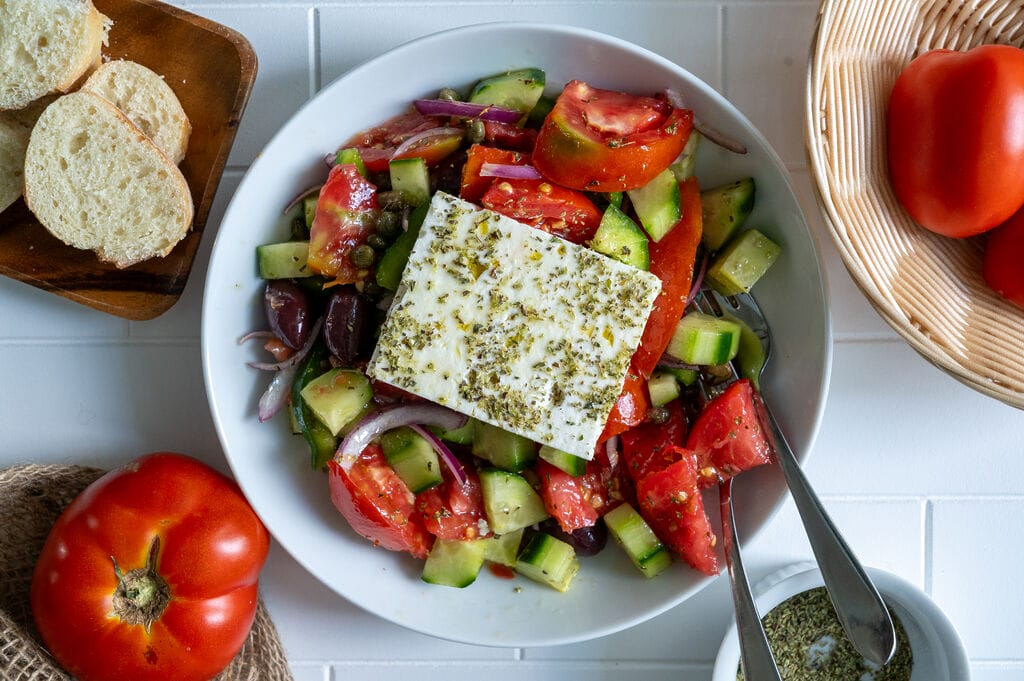
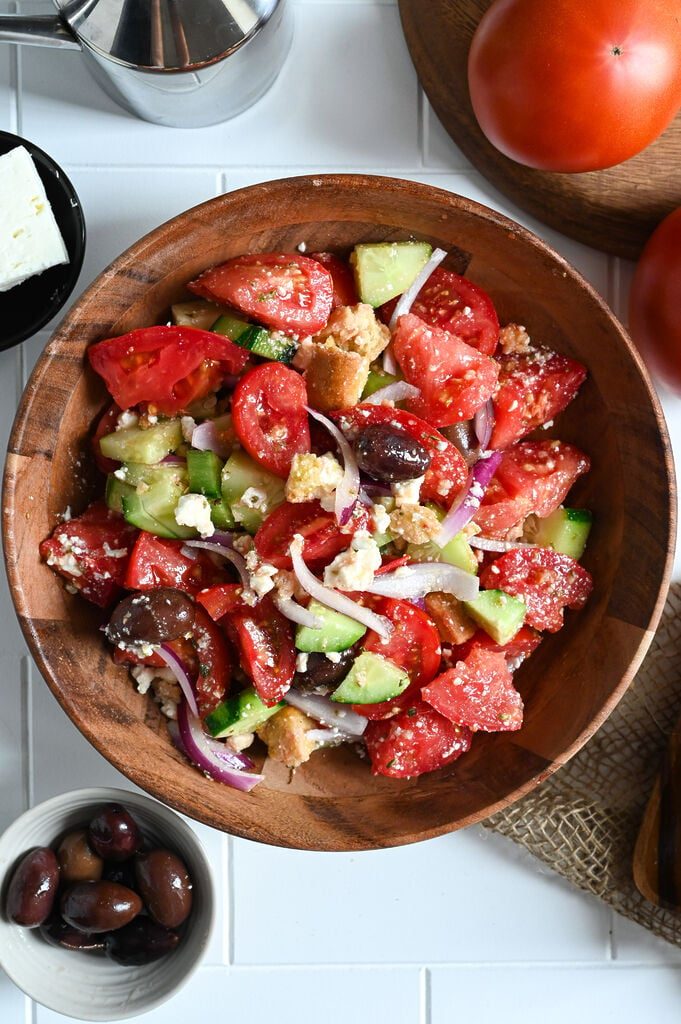
Watch: Video to make Greek horiatiki salad
How to serve
The proper way to eat a horiatiki salata is completely and entirely. This means that after all the vegetables, fruits (Yes, fruits! Go ahead and look up the botanical classifications of tomatoes and olives, friends), and feta are eaten, the juice which is left behind in the bowl is also enjoyed. There are a couple of ways to do this; you can either use some bread to soak up every last bit, or, you can look around, make sure no-one is looking, and quickly, drink it straight from the bowl. I do this all the time, and I am not ashamed!
I often make myself a horiatiki salata and have it as my lunch, with a bit of bread on the side. Otherwise, in the summer, a big bowl of this classic Greek salad is placed in the center of the table, to complement all the other wonderful dishes that are being offered.
Frequently asked questions
Can I make my salad ahead of time?
I like to make my Greek village salad about 15 – 30 minutes before serving it; this allows the flavours to meld together. I don’t like to make it much more in advance because then I might need to keep it in the refrigerator (because of the feta). I never refrigerate my tomatoes!
If refrigerating tomatoes is a no-no, what can I do with leftover horiatiki salad?
I am so glad you asked because I have a brilliant solution! If you have leftover Greek village salad, go ahead and store it in the refrigerator. Then, when you are ready, make this Greek salad egg scramble (Horiatiki strapatsada) – it is incredible, and no ingredients get wasted!
Related recipes
Want more traditional Greek salads? I think you will love these!
Maniatiki Salad (Potato salad with oranges and fennel) A traditional salad from the Mani region of Greece which combines potatoes with oranges and fennel. A great combination.
Roasted beet salad An amazing salad of beetroot, beet greens and feta. Sweet, salty and so good!
Greek potato salad with herbs Move over mayonnaise! We have no need for you when we have this light and herby Greek potato salad to enjoy!


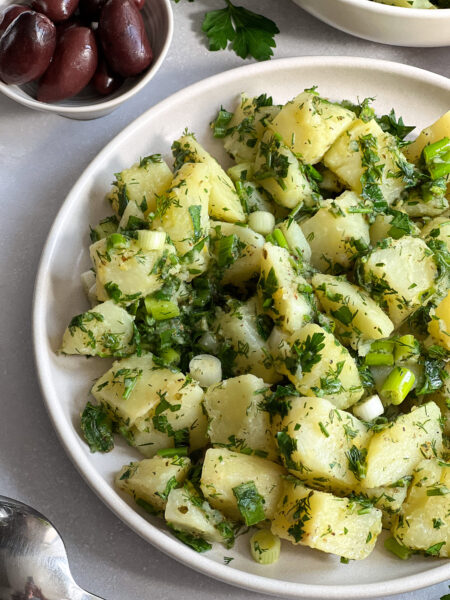

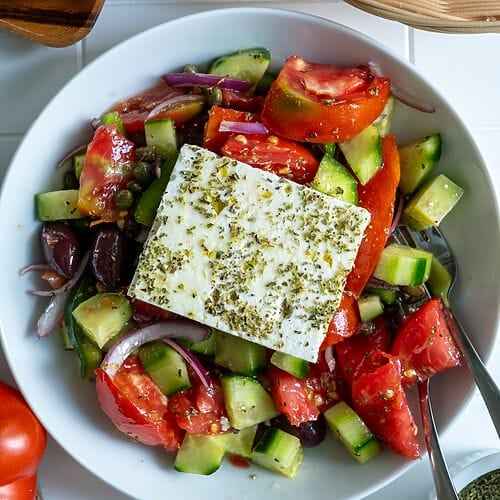
Equipment
- Bowl
Ingredients
- 3 medium sized, vine-ripened tomatoes
- 1 small or 1/2 medium cucumber
- 1/4 cup thinly sliced red onion
- 1/4 cup thinly sliced green bell pepper
- 1 tbsp capers
- 4 slices of feta, each the size of a matchbox
- 6 Kalamata black olives
- 1 ½ teaspoon dried Greek oregano
- 1/2 teaspoon salt
- 2 tbsp Greek olive oil
Instructions
- Wash your tomatoes and cut them in half, length-wise (meaning, cut through the stem end). Then, cut each half into wedges. Place the tomato wedges in a large bowl.3 medium sized, vine-ripened tomatoes
- Wash your cucumber but do not peel it. Depending upon the size of your cucumber, either cut it into rounds, or cut it into rounds which you then cut in half. Add to the bowl with the tomatoes.1 small or 1/2 medium cucumber
- Next, to your bowl add your thinly sliced red onions, thinly sliced green bell pepper, sliced feta, Kalamata olives, and capers. Then, add your dried oregano, salt, and olive oil.1/4 cup thinly sliced red onion, 1/4 cup thinly sliced green bell pepper, 1 tbsp capers, 4 slices of feta, each the size of a matchbox, 6 Kalamata black olives, 1 ½ teaspoon dried Greek oregano, 1/2 teaspoon salt, 2 tbsp Greek olive oil
- Gently mix everything together and serve, preferably with some nice fresh bread.
- Enjoy!
Video
Nutrition
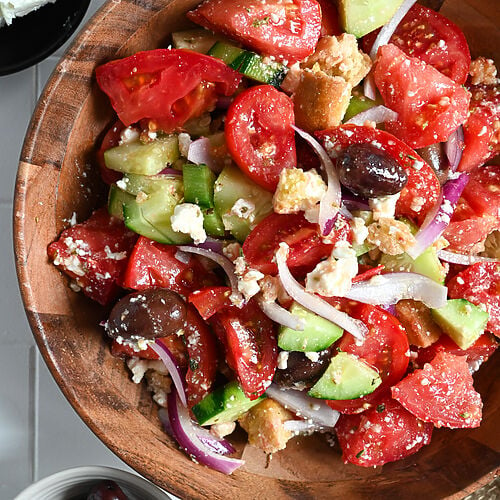
Equipment
- Bowls
Ingredients
- 3 medium sized vine ripened tomatoes
- 1 small or 1/2 a medium cucumber
- 1/4 cup thinly sliced red onion
- 1/4 cup crumbled Greek feta
- 6 Kalamata black olives
- 2 small paximadia (barley rusks), broken into bite-sized pieces
- 1 ½ teaspoon dried Greek oregano
- 1/2 teaspoon salt
- 2 tbsp Greek olive oil
- 1/2 teaspoon red wine vinegar
Instructions
- Wash your tomatoes and cut them into quarters. Cut each quarter into bite-sized chunks. Place in a large bowl.3 medium sized vine ripened tomatoes
- Wash your cucumber but do not peel it. Depending upon the size of your cucumber, either cut it into rounds, or cut it into rounds which you then cut in half. Add to the bowl with the tomatoes.1 small or 1/2 a medium cucumber
- Next, to your bowl add your thinly sliced red onions, crumbled feta, kalamata olives, and pieces of paximadi. Then, add your dried oregano, salt, olive oil and red wine vinegar.1/4 cup thinly sliced red onion, 1/4 cup crumbled Greek feta, 6 Kalamata black olives, 2 small paximadia (barley rusks), broken into bite-sized pieces, 1 ½ teaspoon dried Greek oregano, 1/2 teaspoon salt, 2 tbsp Greek olive oil, 1/2 teaspoon red wine vinegar
- Mix well and serve; don't be shy about having some nice fresh bread with it.
- Enjoy!


Great recipe – had something similar yesterday for dinner. Very tasty! Thank you!
Isn’t it delicious! We have this salad at least once a day in the summer…and never get bored 🙂
.tomatoes, olives, feta are mandatory but if there is not a good dollop of olive oil it’s not a Greek salad. Dear lord, how many Greek salad in Australia have I been served with no olive oil rather a vinegrette dressing… Sigh.. 😞
Oh…that’s a travesty! We agree totally…vinaigrette ruins a horiatiki…plenty of olive oil is absolutely necessary 🙂 🙂
More feta, more Kalamata olives and definitely olive oil and red wine vinegar. I found a great recipe for the dressing: for small salad: 1/4 c olive oil; 1 tablespoon red wine vinegar; 1 tablespoon lemon juice; dried oregano 1 small garlic cloved minced; place all ingredients in a jar, shake, pour onto salad! I lived in Kyllini for 3 1/2 months in 1988 and helped out at a taverna on the beach. I got to make their greek salads, must not have lettuce in there!! (the dressing recipe I found much later) back in the states. Can’t eat my Greek salad without it!
Love Greek Salad…the restaurant I order my salad from puts Balsalmic Vinegar in his as well and its delish 👌😋
We do too Diane!! It’s the best way to enjoy lunch in the summer 🙂
We were recently in Athens and decided we are retiring in Greece! We had a version of this salad and it was DELICIOUS! I am so excited to make it here at home!
You will love it! It is easy, fresh, and so full of flavour! Retiring in Greece sounds like a great plan! xoxo Helen & Billie
Long time follower and have tried many of your beautiful and delicious recipes- v thankful for u to share it all. My question is , where to buy authentic Greek olive oil and feta? I am in Guelph, ON but also frequent TO.
Thank u again.
Hi Sal, thank you so much for being a longtime member of our community! We really appreciate you being here with us 🙂 For the olive oil, to be honest we get ours shipped directly from family in Greece. Having said that, it seems that Costco sells good Greek olive oil (at least in Montreal, so we imagine in Toronto too). If you want to splurge on a really great bottle of olive oil, we highly recommend the Laconiko brand. Not sure how easy it is to find in stores, but it is available online. Also…do you know that if you put olive oil in the refrigerator, it should solidify. If it doesn’t, then it has been diluted with cheaper oils. As for the feta, we often buy Dodoni brand feta – just be sure that it is real Greek feta (and not Greek-style feta). Greek feta is made with sheep milk, or a combination of sheep and goat milk. Anything that contains cow milk is not Greek feta 🙂 Hope that is helpful! xoxo Helen & Billie